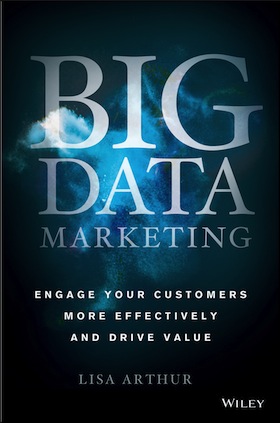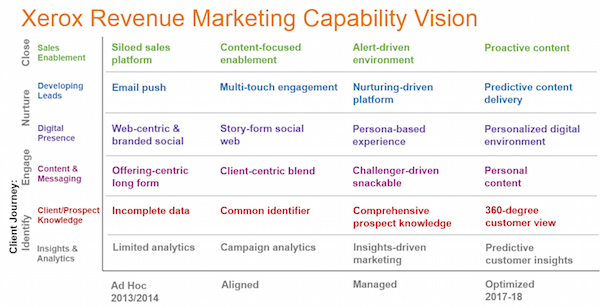As marketers, we have more data at our disposal now than our predecessors could have imagined in their wildest dreams. However, this bounty of data is not without challenges.
Two recent posts I wrote on these challenge — data is the most underutilized asset in marketing and strategic data vs. data theater — were inspired by some excellent research on data-driven marketing conducted by Teradata Applications (formerly known as Aprimo).
In discussing their report with their CMO, Lisa Arthur, I learned that she had recently finished writing a new book, Big Data Marketing, published by Wiley — which was just released today.
It taps into her extensive experience with data-driven marketing in her role as a CMO, as well as the perspective of seeing so many of Teradata’s customers adopt data-centric capabilities into their organizations.
I’m looking forward to reading her book — all profits from which will be donated to the American Red Cross — but in the meantime, Lisa graciously agreed to the following in-depth Q&A on the wondrous intersection of marketing and data.
Can you tell us a little about your background and your current role at Teradata Applications?
I’ve been in technology marketing for 30 years, and this is my fourth CMO role. I’ve been with Teradata Applications (formerly Aprimo) more than four years, and I’m very proud of that because it’s longer than the average CMO tenure and double my past stays in prior positions.
I attribute my “longevity” to three things.
First and foremost, I made the switch from being a brand-type CMO to being a data-driven CMO. In fact, that transition was so pivotal that it inspired me to write the book Big Data Marketing — in many ways it’s a guide based on my transformation and the transformations I’ve seen in other leading data-driven CMOs.
Second, I helped my team adopt agile marketing principles, and now we’re using the same integrated marketing software we sell globally to improve our own go-to-market processes and to extract the data-driven insights which lead to better, more effective marketing.
Finally, I’m passionate about the intersection of marketing and technology — a disposition I think we both share, Scott.
Your book Big Data Marketing, which champions data-driven marketing, was just released today. What makes data-driven marketing different than marketing as we knew it?
Data-driven marketing is different from “old school” marketing because it is all about transparency, relevance, and results.
By transparency, I mean the ability to track the value of marketing and demonstrate the Return on Marketing Investment (ROMI) and how that impacts business. Relevance is about improving access and usage across the entire landscape — content, behavioral patterns, response data, etc. — to provide insights for better go-to-market strategies and more relevant customer engagement.
Marketing as we knew it depended on “spray and pray” and push models. By contrast, a data-driven approach empowers marketers to understand their customers and provide an enhanced experience.
The third area — results — is key. Our research shows that 50% or more of today’s marketing messages are irrelevant, while on the flip-side, marketers who offer meaningful, truly personalized offers see better customer engagement and improved results. That drives real business value.
We recently completed a survey of 2,200 marketers globally and found that nearly eight out of ten of them (78%) are feeling the pressure to be data-driven. Clearly, there is a tidal wave coming from CEOs, CFOs, and boards of directors to drive marketing with data, and marketers know they need to update their strategies from old school to new school.
Clearly, there is a tidal wave coming from CEOs, CFOs, and boards of directors to drive marketing with data.
Big Data Marketing was released by Wiley today, and I think it’s timely and important for marketers. In addition, all profits will benefit the American Red Cross, so we’re excited about it on lots of different levels.
Some marketers might fear that being data-driven comes at the expense of creativity and intuition. How do alleviate their concerns? Can being data-driven actually empower greater creativity?
I absolutely believe that data — and more importantly, the insight derived from data — fuels creativity and inspires better initiatives and campaigns.
When I talk with brand marketers, many push back that I’m an advocate for “losing the emotional” side of marketing and brand. Um, no. In fact, quantitative and qualitative data will help us hone and understand our customers’ emotional hooks and triggers. Agencies and brand managers have been doing this for years. Even better, now we can tie that to results — what content attracts, when do offers work, which messages resonate and which don’t.
In fact, quantitative and qualitative data will help us hone and understand our customers’ emotional hooks and triggers.
Let me give you an example. When I came to Teradata Applications, I gathered lots of data about our category during my on-boarding interviews.The agency we worked did the same. Then, we put all this information together and crystalized our messages into a campaign around “The Marketing Revolution.”
The data helped me sell this creative idea internally to the data team, the CEO, the CFO, and the entire C-suite. The emotion of the campaign’s messages and graphics all sprang from the insights we gained from the data we collected.
Thanks to that process, we learned that not only did marketers need to be woken up, but also that they’d been feeling downtrodden and needed a more “modern” vision. This campaign helped catapult our brand and valuation as a company — and at its core, it was creative data-driven marketing.
To become data-driven, how does the marketing department need to change? New skills, new roles, new ways of managing?
Marketing departments do need to change, no question. In Big Data Marketing, I present five steps that marketing needs to adopt to evolve, and I call these the “Five Steps of Data-Driven Marketing.” Here is a brief recap of each:
Step One: Get Smart, Set Strategic
Too many marketers are tactically-focused. They establish marketing strategies without tying back to core business objectives and their vision for the customer experience. Instead, marketers need to craft a strong, comprehensive strategy based on the customer experience and then build analytical, data, organizational and technology strategies to support it. It all boils down to using data better.
Step Two: Tear Down the Silos
A fresh statistic from our recent Data-Driven Marketing Survey shows that 65% of marketers report misalignment within their own departments, and even more (75%) cite a rift with IT.
The prediction Gartner published in 2012 — that by 2017, CMOs will be spending more on technology than their counterpart CIOs — has CIOs worried that marketing will go drive technology initiatives in a vacuum. It is imperative for CMOs and marketing leaders to tear down the silos within their own organization, build better collaborative working relationships with the CIO and the IT team, and nurture communication and cooperation throughout the enterprise.
CIOs worried that marketing will go drive technology initiatives in a vacuum. It is imperative for CMOs and marketing leaders to tear down the silos.
Step Three: Untangle the Data Hairball
Our survey also revealed that less than 10% of marketers use data in a programmatic way. In today’s data-driven business environment, this just won’t cut it, short-, mid- nor long-term.
One of the biggest obstacles is access to customer data. We found that only 18 percent of marketers have a holistic view of their customer. Why? Because customer information is tangled in what I call the data “hairball” —and that mess is only going to become more convoluted and snarled as big data grows.
Marketers need to work across the business to fix this fragmented customer view and then pilot — with IT’s help — big data projects that will uncover new ways data can add value.
Step Four: Make Metrics Your Mantra
Today, transparency is everything, so why is marketing still struggling to show and prove its value? For starters, the traditional marketing culture stands in the way. Not only do marketers fear they will get fired for poor results; there’s also a lack of understanding of how to measure and drive ROI.
In order to make metrics core to marketing, CMOs and their teams must first define what the terms mean to their organizations (Return on Marketing Investment vs. Return on Investment, e.g.), and then determine the macro metrics that will demonstrate and communicate how marketing’s results are contributing to the business.
Once that’s accomplished and aligned with the broad business goals established in the C-Suite and by the board of directors, CMOs will begin to improve the transparency and visibility of marketing’s business contributions.
Step Five: Process is the New Black
Most business professionals don’t think of process as sexy. However, when a process delivers competitive advantage or elevates the relevance of a brand to its audience, it is very sexy. Marketers have long taken an ad hoc approach to projects and to managing the complexity of marketing processes, but that won’t work anymore.
Marketing needs to be agile, to be nimble, and to get to market sooner, rather than later, to drive revenue and excite consumers. More and more marketers are simplifying, automating and revolutionizing their processes, so they can get products, services and campaigns to market with greater speed and efficiency. Every marketer today is asked to do “more with less,” and process is a key factor in hitting that mark.
Marketing needs to be agile, to be nimble, and to get to market sooner, rather than later, to drive revenue and excite consumers.
These five steps are detailed in Big Data Marketing, along with great examples from companies making these shifts.
What are the challenges that CMOs face in making their organizations data-driven? How do they overcome them?
One of the biggest challenges CMOs face is strengthening the relationship between marketing and IT. The results from our Data-Driven Marketing Survey show that only one out of four marketers is confident in the relationship between marketing and the CIO or IT.
They either need to hire a chief marketing technologist or a chief digital officer to bridge that gap, or they need to build the bridge themselves. To address this challenge, I counsel CMOs to start with Step One above — Get Smart, Get Strategic — and to collaborate with their CIOs, CEOs, indeed the entire C-suite, to get buy-in and evolve data-driven marketing strategies.
They either need to hire a chief marketing technologist or a chief digital officer to bridge that gap, or they need to build the bridge themselves.
Once those relationships are established, marketers can create a shared framework grounded in what’s important to the business — namely, the customer — so all departments have a common reference to point back to when (the inevitable) breakdowns occur.
The other opportunity for establishing cross-departmental rapport is to pick a project based on the company’s overarching strategy — it could be a big data project or an integrated marketing platform integration that helps them scale — but pick one and get started. Nearly any joint project will help forge a better working collaboration.
Another big challenge is talent. Most CMOs can’t make the move to become more data-driven simply because they lack data analysts and insight specialists on their teams. What CMOs need is someone who’s “been there and done that” — and for many, the best solution is to look externally for experts who can augment existing teams.
How does data-driven marketing impact the relationship between marketing and IT? Are there models of collaboration between these two groups that you think are particularly effective?
The evolution of marketing to become data-driven is a perfect vehicle to forge that stronger relationship with IT.
I recently met with a group of CIOs from major brands, and all admitted they fear that marketing will attempt this evolution in a vacuum. Yet, at the same time, they said they realize that a synergistic relationship is critical for the CMO and the business to be successful.
The best model I’ve seen is where a data-driven CMO — or a core member of his/her leadership team working hand-in-hand with the CMO — takes the first steps to untangle the data hairball. The process starts by implementing an integrated marketing management platform to consolidate the many fragmented systems in marketing. Quite literally, that work drives the collaboration.
Agile marketing plays well here, as well, and is probably central to the best implementations I’ve seen to date.
I’ve read that you’ve embraced agile marketing at Teradata. Can you share some of your experience with adapting agile management practices in your organization, or what you’ve seen with other customers?
Yes, we embrace an agile approach both in our marketing and in our software development, and we’re seeing many of our leading customers do the same. For our own marketing department, we started following agile back in 2009, spent about nine months making the shift, and are still working this way now.
I find there are three indicators that make agile marketing work well. The first is a culture of collaboration and teamwork. The second is an unwavering focus on the customer relationship/customer experience. And the third is a commitment to flexible and market responsive process.
I find there are three indicators that make agile marketing work well. The first is a culture of collaboration and teamwork.
In a nutshell, at Teradata Applications, we try to keep everything extremely strategic, meaning, ever focused on the customer. To prevent silos from impeding our progress, we combine teams every few quarters to keep things fresh and to remind us that marketing’s purpose is to enable sales to sell.
Of course, the underlying, unifying aspect is Teradata’s relationship with the customer. Yes, agile has proven to be a very inspiring and rewarding approach. It has made us better at what we do and has significantly improved our customer relationships.
If you could offer just one piece of advice to a fellow CMO who is contemplating data-driven marketing, what would you say?
My advice would be to keep your eyes on the prize. Always remember that the transformation to data-driven marketing isn’t a short one or a solo one.
First, nail down your vision around the customer experience or customer journey and get the C-suite to buy in. first. Then, identify what is needed from ananalytics, data, organization and technology perspective.
After that, once everyone’s eyes are on the prize, collaborate like hell using that singular focus to build an executable roadmap and move forward. Don’t fear failure. Striving for “perfection” is a waste of time because at the beginning of the journey. We don’t know what we don’t know, but we do know we will discover those insights through collaborative processes and data as we move.
Whew, so much more I could say here!
Thank you, Lisa!





Great post! Just ordered my copy of Big Data Marketing.
5 great steps. I’ll be buying the book to find out more. Thanks for sharing